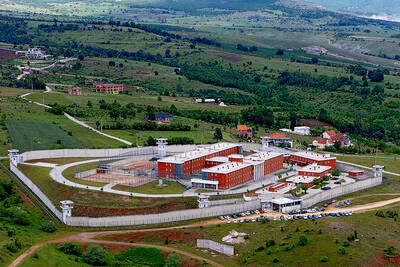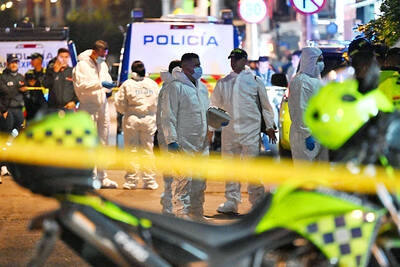The ruins of an ancient temple built by a long-vanished kingdom in southern India are being excavated by archaeologists who say the sanctum may have been destroyed centuries ago by a tsunami.
The temple was found in the region affected by the Dec. 26 Asian tsunami, and the "discovery now poses very interesting questions ... about the history of tsunamis," the archaeologist leading the excavation, Thyagarajan Satyamurthy said Wednesday.
The temple appears to have been built between the second century BC and the first century AD It was excavated this month just north of Mahabalipuram, a port town 50km south of Madras, in the southern state of Tamil Nadu, by a team from the government Archaeological Survey of India, Satyamurthy said.
"This is the earliest temple discovered in this region so far," Satyamurthy said.
The archaeologists are trying to determine the date of the tsunami that may have destroyed the temple from sand and seashells found at the brick structure, dedicated to Lord Muruga, a Hindu god, Satyamurthy told reporters.
He said there was more damage on the side of the temple facing the sea, and that the sand and shells were not normally found so far inland.
Geophysicists at a government laboratory in southern Trivandrum city called them "palaeo-tsunami" deposits, he said.
The temple was found one layer below a granite temple excavated by the same team in July, leading archaeologists to theorize that the Pallava kings, who ruled the region between 580AD and 728AD, built the latter temple atop the remains of the older one.
The team also found stucco figurines, terra-cotta lamps, beads and roofing tiles. Similar articles and large bricks were typically used around the beginning of the first millennium, he said.
Mahabalipuram, the capital of an ancient kingdom, is already well known for its intricately carved shore temples that have been declared a World Heritage site and are visited each year by thousands of Hindu pilgrims and tourists.
According to descriptions by early British travel writers, the area was also home to seven pagodas, six of which were submerged by the sea.
But just as an ancient tsunami may have ravaged the temple outside Mahabalipuram, last year's Indian Ocean tsunami revealed other temples and monuments that had been buried for centuries.
In February, archaeologists began underwater excavations of what is believed to be an ancient city and parts of a temple uncovered by the waves.
Three rocky structures with elaborate carvings of animals emerged near Mahabalipuram after the waves receded, washing away sand deposits that had covered the structures, which archaeologists have said appear to belong to a port city built in the seventh century.
The ruins of the temple were not uncovered by the recent tsunami, and excavation did not begin until after the waves struck.

By 2027, Denmark would relocate its foreign convicts to a prison in Kosovo under a 200-million-euro (US$228.6 million) agreement that has raised concerns among non-governmental organizations (NGOs) and residents, but which could serve as a model for the rest of the EU. The agreement, reached in 2022 and ratified by Kosovar lawmakers last year, provides for the reception of up to 300 foreign prisoners sentenced in Denmark. They must not have been convicted of terrorism or war crimes, or have a mental condition or terminal disease. Once their sentence is completed in Kosovan, they would be deported to their home country. In

Brazil, the world’s largest Roman Catholic country, saw its Catholic population decline further in 2022, while evangelical Christians and those with no religion continued to rise, census data released on Friday by the Brazilian Institute of Geography and Statistics (IBGE) showed. The census indicated that Brazil had 100.2 million Roman Catholics in 2022, accounting for 56.7 percent of the population, down from 65.1 percent or 105.4 million recorded in the 2010 census. Meanwhile, the share of evangelical Christians rose to 26.9 percent last year, up from 21.6 percent in 2010, adding 12 million followers to reach 47.4 million — the highest figure

LOST CONTACT: The mission carried payloads from Japan, the US and Taiwan’s National Central University, including a deep space radiation probe, ispace said Japanese company ispace said its uncrewed moon lander likely crashed onto the moon’s surface during its lunar touchdown attempt yesterday, marking another failure two years after its unsuccessful inaugural mission. Tokyo-based ispace had hoped to join US firms Intuitive Machines and Firefly Aerospace as companies that have accomplished commercial landings amid a global race for the moon, which includes state-run missions from China and India. A successful mission would have made ispace the first company outside the US to achieve a moon landing. Resilience, ispace’s second lunar lander, could not decelerate fast enough as it approached the moon, and the company has

‘THE RED LINE’: Colombian President Gustavo Petro promised a thorough probe into the attack on the senator, who had announced his presidential bid in March Colombian Senator Miguel Uribe Turbay, a possible candidate in the country’s presidential election next year, was shot and wounded at a campaign rally in Bogota on Saturday, authorities said. His conservative Democratic Center party released a statement calling it “an unacceptable act of violence.” The attack took place in a park in the Fontibon neighborhood when armed assailants shot him from behind, said the right-wing Democratic Center, which was the party of former Colombian president Alvaro Uribe. The men are not related. Images circulating on social media showed Uribe Turbay, 39, covered in blood being held by several people. The Santa Fe Foundation